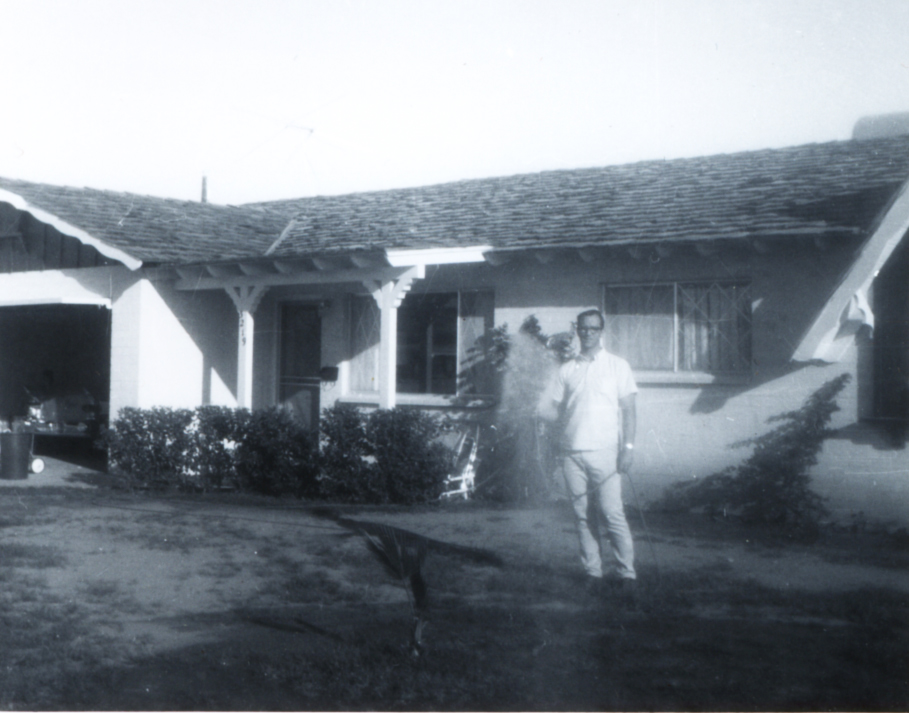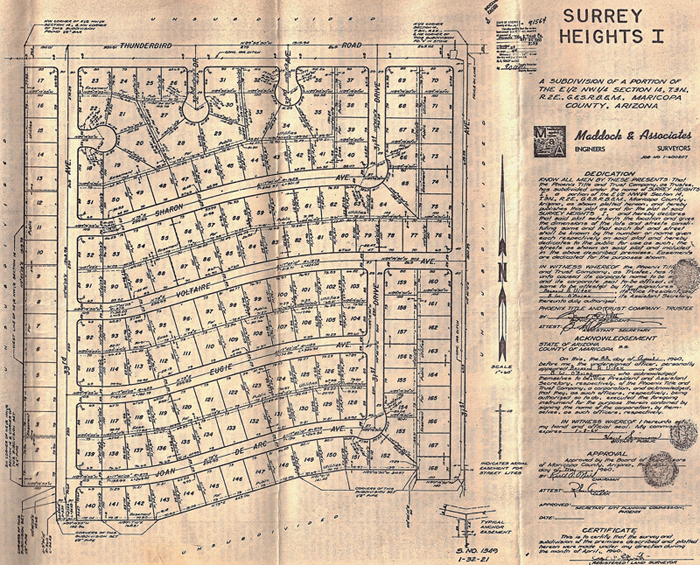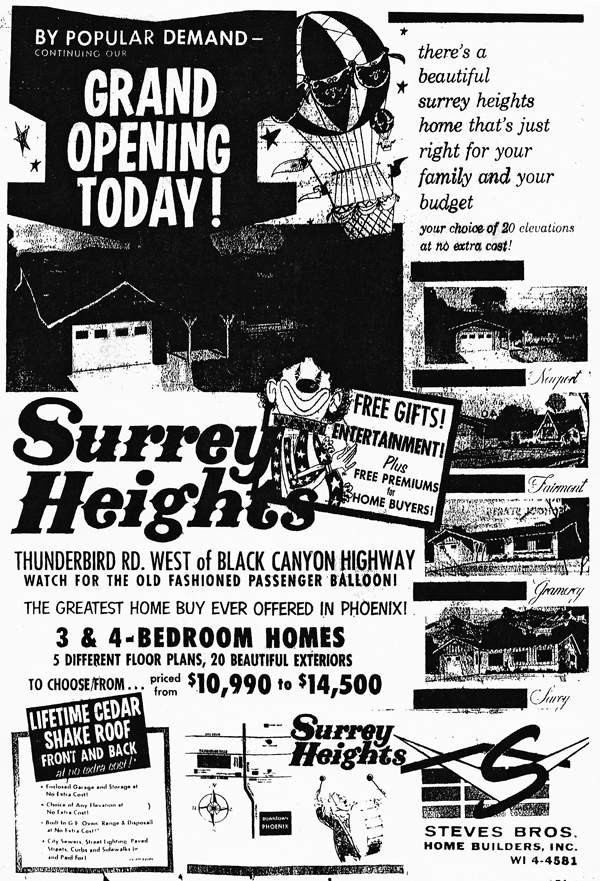Phoenix, Arizona / Wednesday, August 24, 2011 © 2011 by JPB Publishing Ltd. Avenue Weather: Partly cloudy with possible late afternoon showers. High 112 / Low 90 On the INSIDE: Editorials A2 / Nostalgia A3 / Crossword A4
Joan De Arc hits 50
(BP) - The Avenue is now officially middle-aged. 2011 marks the 50th anniversary of the building of the homes on Joan De Arc Avenue, a genuine historical milestone that has somehow elicited curiously little interest among current residents on the street. Fortunately of course, there still exists an old, obscure street newspaper to take note of such momentous occasions. Apparently named by someone with an unusual fondness for medieval French religious martyrs, Joan De Arc Avenue came into being in early 1961 as the final street in Phase I of the Surrey Heights subdivision of homes. Construction took place intermittently throughout that year, with the last homes on the street finished up in early ‘62. The initial years on Joan De Arc were characterized by a steady influx of immigrants from various parts of the country, forming a pleasingly eclectic blend of residents. Bill and Helen Mitchell and their girls were among the first families to appear on the street, arriving from North Dakota and moving into their home at 3231 on August 11, 1961. For some unfathomable reason, they never did leave. As families continued to populate the street, Joan De Arc slowly began to take on its remarkably unique character. Neighbors actually socialized with each other on a virtually daily basis, and a tight-knit hamlet of residents soon emerged. Many of these friendships continue on to the present day, and regard for the old street among former inhabitants seems only to grow with time. So why should the 50th birthday of an obscure, middle-class residential street in northwest Phoenix, Arizona be of any real significance in the grand scheme of things? When asked to comment, former resident and Crusader CEO John Bueker remarked, “Well, it’s not terribly significant. It’s just a good opportunity to reflect back on a lovingly remembered and simpler past. That’s all. It was a heck of a nice place to grow up.” Perhaps, on reflection, it is perfectly understandable that the Mitchells never did leave.
Brief timeline of Joan De Arc Avenue By J. Beaver The staff of the Crusader got together last week and compiled the following timeline of Joan De Arc history over margaritas at Macayo’s:
* March 1961 – Construction begins * August 1961 – Mitchell family moves in * December 1963 – Bueker family appears * January 1964 – Chuckie Hater Club is formed * June 1964 – Carl Bueker shocks world by springing for dinner and a movie for his family * October 1964 – Barbara Bueker begins career as artist * August 1964 – Wells family arrives on street * April 1968 – Joan De Arc Crusader newspaper debuts * June 1968 – Sue Bueker officially becomes a hippie * October 1968 – Bueker kids finally get to go to Neptune’s Garden tropical fish store * June 1970 – Insa the cat catches a bird * November 1970 – Barbie Bueker elevated to “princess” status * November 1971 – Carl and Chuck Bueker invent the “Time-in, Time-out” game * January 1972 – The Joan De Arc Cowboys football team wins 3rd consecutive CFL championship * June 1972 – John Bueker forced to leave Sahuaro School, reluctantly accepts diploma * February 1977 – Bueker family departs Joan De Arc Avenue * August 2011 – Avenue observes 50th anniversary
Surrey Heights: Built to last by J. Bueker “The greatest home buy ever offered in Phoenix.” Such was the sales pitch served up by the Steves Brothers home builders in the summer of 1960 for their newly-minted Surrey Heights subdivision of homes. And while that grandiose claim was probably a bit over the top, there was unquestionably some degree of truth to it. The houses of Surrey Heights were attractively designed, extremely well made, and very reasonably priced. Few other local home builders of the day were offering anything of remotely similar value. The story of Surrey Heights began with three brothers from Buckeye, Arizona – Jim, Leon, and George Steves. In 1955, the brothers Steves formed Steves Brothers Construction Co. and migrated to Flagstaff to pursue their dream of becoming home builders. Over the next decade, Steves Bros. would build over 1,000 homes in the Flagstaff, Winslow and Phoenix areas, beginning with Pine Park Manor and Greenlaw Estates in east Flagstaff. Interestingly, Steves Bros. employed the very same home building formula and materials when crafting their homes in sunny Phoenix as they used in the much cooler and more rugged climes of Flagstaff. As a result, the houses in Surrey Heights were very rigorously constructed from high quality building materials and fitted with extensive amounts of insulation. “The homes on Joan De Arc Avenue were built to last,” observes long-time former resident Barbara Bueker Stewart. “And that they have.” The builders chose an unincorporated patch of land beyond the outskirts of northwest Phoenix for their Surrey Heights development, south of Thunderbird Rd. and west of 31st Ave. Surrounded by open fields on all sides, the homes of Surrey Heights were constructed literally on the extreme outer boundaries of civilization, a remote parcel of real estate that would not be annexed by the city of Phoenix until 1962. Surrey Heights and its sister Westown development were in fact considered so far north of town at the time that the sanity of the developers was questioned in some quarters.
However, the homes in Surrey Heights were priced to sell. The 3 and 4-bedroom models ran from $10,990 to $14,500, and home buyers received an excellent value for their money. Five different floor plans were originally made available, including The Newport, The Fairmont, The Gramercy and The Savoy. All of the models featured attractive amenities including a lifetime cedar shake roof, enclosed garage, and built-in GE oven, range and disposal. No fewer than 20 different facades were designed for the homes, lending an exceptional richness and variety to the architectural style of the newly born neighborhood. The construction of Surrey Heights Phase I commenced in the summer of 1960 and would approach completion the following year with the building of the homes on Joan De Arc Avenue. By July of ‘60, the builders were already hosting a series of “grand opening” events in the cul-de-sac at 3200 W. Thunderbird Rd., where the subdivision office and model homes were situated. The promotions emphasized family entertainment, with clowns, food, prizes, and a full-sized, old-fashioned hot-air passenger balloon on hand to entice prospective home buyers. Advertisements for the events appeared in a series of Sunday editions of the Arizona Republic that summer. The hot-air passenger balloon acquired by Jim Steves for the grand opening events was destined to become a legendary part of the Surrey Heights saga. Kathryn Willis, daughter of Jim Steves and herself a home builder for many years, recalls a remarkable story about the balloon that her father was still fond of recounting decades later. One afternoon during the Surrey Heights grand opening festivities, so the story goes, the passenger balloon somehow escaped its moorings and slipped off into the ether, à la The Wizard of Oz. Fortunately unoccupied at the time, the balloon drifted across state lines, was reported as a UFO, and then finally got shot down over the state of Oklahoma. Ms. Willis believes the story “could be a little exaggerated,” but given the collective paranoia of the early Cold War era, the tale actually sounds entirely plausible. In any event, the Surrey Heights hot-air passenger balloon was never heard from again. Surrey Heights was inevitably expanded upon by a series of additions over the following decade. Steves Bros. commenced the building of Surrey Heights Phase II in early 1962, shortly after the completion of Phase I, extending the neighborhood from Willow Ave. all the way down to Sweetwater Ave. and the northern terminus of the Westown subdivision. Ultimately, a half dozen phases of Surrey Heights would be built by various developers, ending with the completion of Phase VI in 1971. Today, the Surrey Heights subdivision remains a vibrant community, a well-established neighborhood no longer perched beyond the dusty frontiers of Phoenix suburbia. Once a lonely outpost on the fringes of civilized society, the area has long since been swallowed up by the sprawling Valley megalopolis and settled into a sleepy existence as just one of countless subdivisions in the northwest corner of town. If one looks closely enough though, a few remnants of the original neighborhood landscape yet remain. A handful of those “lifetime cedar shake roofs” still sprinkle the neighborhood, among them one on Joan De Arc Ave. at 3121. A significant number of the original GE ovens and stoves are still in operation 50 years later, and the Steves’ unique architectural vision remains vivid, despite all manner of remodeling done to the homes throughout the years. Their work endures. All in all, Surrey Heights stands as a tribute to a visionary home builder and a bygone era when quality and craftsmanship still mattered at least as much as time and profit. _____________________________________________________________________________________________________________________JDA
On the INSIDE: Editorials A2 / Nostalgia A3 / Crossword A4
Moon Phases:
|
|||



